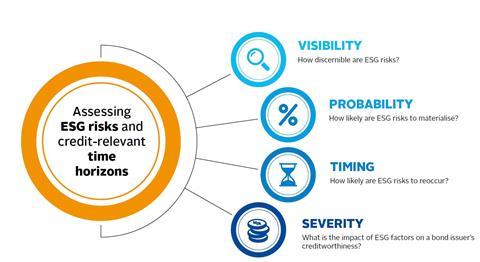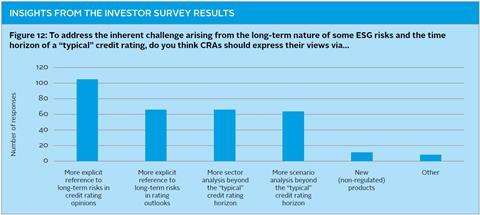An overview of the PRI’s observations on the investor-CRA disconnect related to relevant time horizons to consider.
Key messages:
- Time horizon considerations vary depending on investment objectives and whether the credit risk of a bond issuer or a single issue is assessed.
- They also depend on the visibility of future risks, the probability that they will materialise and whether they impact a bond issuer’s cash flow and balance sheet, as well as its ability to adjust business models in line with changing ESG risks.
- The biggest challenge credit practitioners face is modelling non-financial ESG risks and capturing data interdependency.
What we observed:
Relevant time horizons differ. Different investors have different objectives, with AOs more sensitive to long-term risks, as they tend to buy and hold long-dated bonds for asset-liability management. Similarly, investors in private debt instruments are relatively more concerned about long-term risks as they finance long-dated projects. Time horizons also depend on the maturity of a bond and on whether a company generates enough cash flow to meet the debt repayment.
Timing of ESG factors’ impact on credit risk. Participants considered that some ESG factors emerge gradually (for example, as a result of poor strategy choices or business planning). Meanwhile, others unexpectedly become evident at a specific time, with potentially significant market repercussions. Some may never manifest, if, through engagement, bond investors point out shortfalls and influence an issuer’s future course of action.
Push for more forward-looking analysis. Some investors commented that CRAs are too reactive (a point challenged by the CRAs) and that providers of sustainability scores often rely on stale information. With this in mind, attendees discussed how scrutinising ESG factors can promote a more forward-looking approach to credit risk analysis. They considered the benefits of gathering more insight about future environmental and social policies to better leverage information and evaluate the quality of an issuer’s approach to governance.
Risks historically perceived as long term are surfacing. There was also recognition that risks once regarded as too far off to materially impact an issuer’s cash flow and funding ability are now more visible. For example, the frequency and magnitude of climate change-related incidents is increasing. Meanwhile, growing calls for corporate governance to align approaches with long-term value creation is bolstering investor and regulatory scrutiny, and, with that, the risk of reputational consequences or inadequate preparation for policy changes.
The importance of monitoring. Participants also discussed whether the frequency that investments are reviewed, once material threats are identified, is more significant than overall time horizon. This approach is already embraced by CRAs that review all issuers at least once a year, but may monitor more frequently those rated speculative grade, given their higher risk. Markets have the advantage of being able to react more quickly to unexpected events, but CRAs are relatively better positioned to anticipate certain surprises because they meet issuers’ management more frequently.
| Challenges |
|---|
|
Capturing interdependency of data/event/time horizon. Conversations revealed widespread difficulties among participants in understanding how to best consider the interplay between: 1) the forces that drive ESG risks (structural trends that are typically long term in nature); 2) the probability that ESG incidents materialise as shocks (which typically occur at a specific time); 3) the risk of ESG hazards reoccurring; and 4) their impact on the issuer’s creditworthiness. Modelling ESG risks. This is not easy for a FI community that typically relies on back-testing. Past ESG data may not exist, or may not have been provided or disclosed regularly or on a comparative basis – and, even if it does exist, it may not have previously been “priced in”. Modelling the non-linearity of ESG risks and capturing data interdependency is also a challenge. Ramping up strategy and scenario analysis. Building on the TCFD recommendations, participants discussed the benefits of scenario analysis (for strategic planning and risk management purposes). However, issues of concern around scenario analysis include ascertaining plausibility and how many scenarios to consider. As investors, CRAs and bond issuers have come to expect scenario analysis, another aspect to consider is how to ensure consistency for peer comparability. Assessing refinancing risks. For long-term FI investors, this is critical as the funding ability of an issuer may be affected by market, regulatory or policy changes. Participants considered that a higher cost of capital may negatively impact an issuer’s credit profile. Therefore, the longer the maturity of a bond, the more important it is that practitioners take a holistic approach to risk assessment and focus on the sustainability of an issuer’s business model. |


Download the full report
-

Shifting perceptions: ESG, credit risk and ratings – part 2: exploring the disconnects
June 2018
ESG, credit risk and ratings: part 2 - exploring the disconnects
- 1
- 2
- 3
- 4
- 5
 Currently reading
Currently readingDisconnect 2
- 6
- 7
- 8
- 9
- 10



















